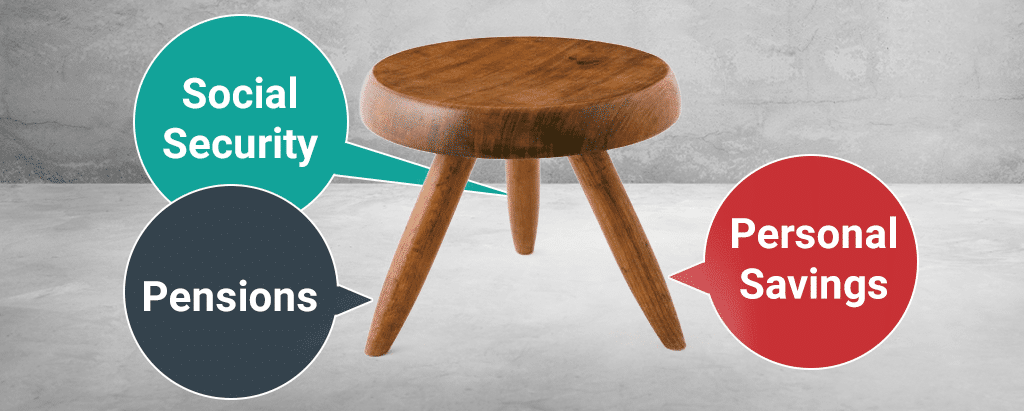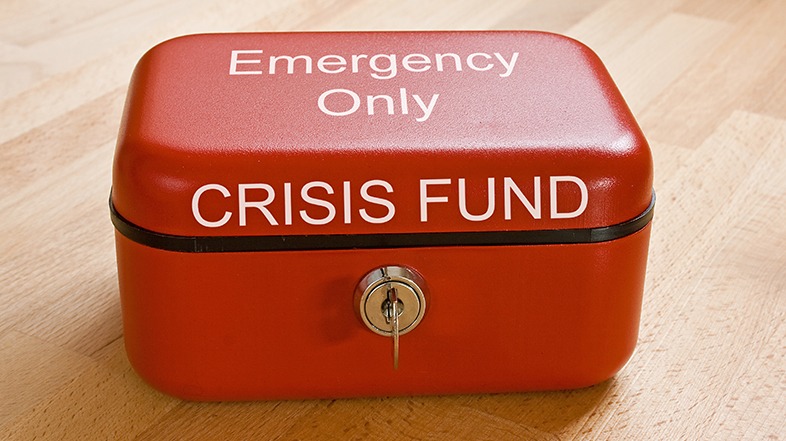
What Happened to the Three-Legged Stool of Retirement?
The three-legged stool of retirement is a term the financial industry once used to describe the three common sources of income that, when combined, would provide people a secure retirement.
The three legs are…
- Social Security
- Pensions
- Personal Savings
Much like a stool, each financial leg was meant to carry its weight to support people in retirement.
None of the legs were meant to individually support people on their own.
With pensions gone for most Americans and the future of Social Security uncertain, personal savings is the only leg remaining that people can count on to support them in retirement.

The dismantling of the 3-legged stool of retirement has, in large part, contributed to the retirement crisis in America.
And with one leg of the stool gone, and one leg frail…
It’s more important than ever to focus on personally saving for retirement, which includes funding your 401(k).
Yet, the U.S. Census Bureau released data in late 2018 that showed the median retirement account balance among all working Americans is $0.00.¹
The same report revealed that “57 percent (more than 100 million) of working age individuals do not own any retirement account assets in an employer-sponsored 401(k)-type plan, individual account or pension.”²
To say that Americans are sorely underprepared for retirement is an understatement.
Keep reading for tips on how to reach your retirement goals faster.
#1 Pensions

For a majority of Americans, pensions are a thing of the past.
Instead, they’ve been replaced by 401(k)s and other workplace-defined contribution plans, such as 403(b), most 457 plans, and The Thrift Savings Plan used for federal employees.
Those with pensions aren’t in better shape than those without one.
According to the Pension Rights Center, the median private pension was $9,376 a year, noting federal, state, and local pensions were higher.³
#2 Social Security

Social Security is set to run out of money in 16 years at the current rate of output.⁴
According to the the 2019 Annual Report of the Board of Trustees of the Federal Old-Age and Survivors Insurance and Federal Disability Insurance Trust Funds (OASDI)…
“OASDI cost is projected to exceed total income starting in 2020, and the dollar level of the hypothetical combined trust fund reserves declines until reserves become depleted in 2035.”⁵
Not good.
The report continues: “At the time of depletion of these combined reserves, continuing income to the combined trust funds would be sufficient to pay 80 percent of scheduled benefits.”⁶
This, of course, is hypothetical and does not take into consideration policy changes. Nor does it account for people retiring later, increased revenues, or rising interest rates.
And the chances of the government allowing Social Security to fail is unlikely.
But this data is a cause for concern.
With Social Security shaky and the future unknown, it further underlines the importance of working to increase your personal savings for retirement.
#3 Personal Savings

The final leg in the three-legged stool of retirement is personal savings, which includes your 401(k).
And, yet, only 20% have saved 5% or less of their annual income and less than one-third of Americans have saved 11% or more, this according to a February 2018 Bankrate study.⁷
The same study reported that 40% of respondents aren’t saving for retirement because they have too many other expenses.
16% said they “haven’t gotten around to it,” and another 16% blame their low-quality job.⁸
While the outlook for American’s in retirement is bleak, the good news is you have total control over this last leg and you can start building your personal savings today.
Below is a checklist you can use to optimize your retirement savings and take control of your financial future.
#1 Pay Off Debt

Debt is one of the contributing factors to the retirement crisis in America.
Credit cards, student loans, outstanding medical bills, or any other debt that’s incurring interest–Americans just have too much of it.
Debt not only prevents you from maximizing your retirement savings, but it may also affect your retirement lifestyle should you carry that debt into retirement.
Staying out of debt is one of the keys to reaching your financial goals for retirement, as well as building wealth.
The key to eliminating your debts starting today is to come up with a plan that will allow you to pay it off while saving for retirement, and being able to cover all your monthly expenses.
This probably means you will have to rethink your spending habits and cut back. Before buying something new, ask yourself if is this something you need or want? If it’s a want, don’t buy it.
It will take discipline and focus. But with a plan and a little determination, you can do it!
Follow these steps to eliminate debt:
- Add up all the debt you owe and the interest, and create a plan to get that debt paid down. If you aren’t sure of the best strategy to pay it all off, do an internet search or use debt pay-off calculators to figure out which bills to pay down first.
- Review your monthly budget and see what expenses you can cut, and then apply that money saved toward paying off debt. If you don’t have a budget, create one.
- Do whatever you can not to incur any new debt. Creating an emergency fund (which we discuss below) will help you to pay for unexpected expenses in cash and not go into more debt.
- Make sure to review your debt pay-off plan monthly to track your progress
For many people, cutting monthly expenses alone might not be enough.
Depending on how much debt you owe, you might need to take on a side hustle or sell things to pay it off.
If you’re close to retirement and have crippling debt, it might be necessary to downsize and sell your home. Use the profit to pay off debt and fund your retirement savings.
#2 401(k) Company Match

If you can’t max out the annual contribution limits for a given year, at least put in enough to get the full company match.
Because when your company matches you, it’s like getting free money!
In some cases, it may double the amount of what you’re already saving.

According to Vanguard’s How America Saves, only 13% of employees with retirement plans at work saved the then-maximum 401(k) contribution limit of $18,000 in 2017.⁹
At 401(k) Maneuver™, we cannot stress enough how important it is that you contribute at least the minimum of what your company will match.
Because it may increase your retirement lifestyle. And it may help you accumulate the amount of money you desire at retirement.
Remember, you don’t have to wait for enrollment season to make changes to your 401(k) election.
You can make changes anytime during the year!
#3 Build an Emergency Fund Sooner Rather Than Later

According to the US Federal Reserve, 4 in 10 adults would either not be able to cover $400 worth of unexpected expenses or would cover it by selling something or borrowing the money.¹⁰
Having an emergency fund helps cover unexpected expenses without stressing, or having to borrow or carry a balance on your credit card.
When something unexpected arises, the last thing you need is to go into debt to pay for that new AC unit, an emergency vet bill, or car repair.
When this happens, it makes it harder to pay it back and continue saving and covering living expenses.
For example, if your credit card has a 21% APR, your $1,000 credit card purchase to cover an emergency could cost you $1,210 over the year, or even more over time.
And to make matters worse, many credit cards charge annual fees, late fees, and over-the-limit fees, which compound the interest rates.
Can you really afford the additional $210?
Some people cut back on saving for retirement instead to cover unexpected expenses.
Should you decide not to contribute to your 401(k) for a month to pay for an emergency, it hurts your future retirement income. Depending on how big the unexpected expense is, it may significantly set back your savings goal.
If enough unexpected bills come up over the years, and to cover them you defer paying into your 401(k), it can do some real damage to your retirement income goals.
You might already be saving for retirement, but are you funding a rainy-day fund as well?
If not, you should start now.
Experts advise people to save 10 – 15% of their income.
If you’re putting 8% of each paycheck into your 401(k) or other workplace retirement account, take the remaining 2 – 7% and fund a savings account for emergencies until the account is funded.
If you’re already saving 15% of each paycheck, then find a way to put an additional 1 – 5% into your cash reserves.
Building an emergency fund may mean you can’t save as much for retirement in the short term. However, it will significantly help in the long run and ensure you stay on track with your retirement savings goals.
#4 Pay Yourself First

When you get paid, before you do anything else (pay bills, buy groceries, or buy anything), pay yourself first.
Meaning, you pay into your savings and investments first..
If you have a 401(k), your savings are automatically taken out of each paycheck. If you have an Individual Retirement Account (IRA), you should be paying into this first as well.
Same goes for savings for your emergency fund. Pay into this before you pay any of your bills. Once you’ve paid yourself, then pay your bills.
Whatever is left over is yours to spend however you want.
If you don’t have much left to spend at the end of a pay period, just remember, you’re building a nest egg for the future. And, should an emergency arise, you’ll be able to pay for it in cash and not have to borrow.
Saving for retirement is a long game.
The sooner you start, the better your chances are of ending ahead, or at least on track.
Check out our retirement calculator to see how much you’ll need at retirement, and see how professional help may improve your future retirement nest egg.
If you’re stuck, we recommend seeking third-party advice as soon as possible.
Download our GUIDE How to Supercharge Your 401(k) Performance Today to learn more.

Sources
- https://www.nirsonline.org/2018/09/new-report-finds-nations-retirement-crisis-persists-despite-economic-recovery/
- https://www.nirsonline.org/2018/09/new-report-finds-nations-retirement-crisis-persists-despite-economic-recovery/
- https://www.cnbc.com/2019/04/01/theres-a-retirement-crisis-in-america-where-most-will-be-unable-to-afford-a-solid-life.html
- https://www.ssa.gov/OACT/TR/2019/tr2019.pdf
- https://www.ssa.gov/OACT/TR/2019/tr2019.pdf
- https://www.ssa.gov/OACT/TR/2019/tr2019.pdf
- https://www.bankrate.com/banking/savings/financial-security-march-2019/
- https://www.bankrate.com/banking/savings/financial-security-march-2019/
- https://institutional.vanguard.com/VGApp/iip/site/institutional/researchcommentary/article/HowAmericaSaves2018
- https://www.federalreserve.gov/newsevents/pressreleases/other20180522a.htm








